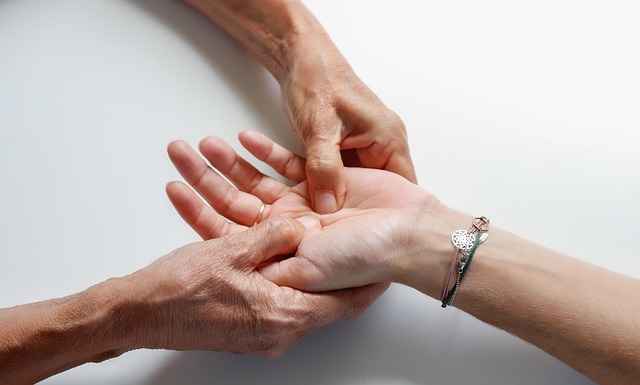Panic attacks are intense episodes of fear with physical symptoms, triggered by stress, anxiety, trauma, medications, or health conditions. Effective anxiety treatment for panic attacks involves Cognitive Behavioral Therapy (CBT), which identifies and changes negative thought patterns, exposure therapy to confront fears, mindfulness and relaxation techniques, medication like SSRIs and beta-blockers, healthy lifestyle changes including diet, exercise, sleep, and support groups or therapy. Integrating these strategies offers holistic anxiety management for reduced panic attacks and improved well-being.
Do you experience sudden and intense fear or discomfort? If so, you might be suffering from panic attacks. This comprehensive guide delves into effective anxiety treatment options. From understanding the symptoms and triggers of panic attacks to exploring evidence-based therapies like Cognitive Behavioral Therapy (CBT) and Exposure Therapy, this article covers it all. Learn about mindfulness techniques, prescription medications, lifestyle changes, support groups, and more, empowering you to take control of your mental health.
Understanding Panic Attacks: Symptoms and Triggers

Panic attacks are intense episodes of fear or discomfort that can come on suddenly, often with no apparent cause. They can be a debilitating experience, characterized by symptoms such as rapid heartbeat, sweating, trembling, shortness of breath, and a feeling of impending doom. These symptoms can be so overwhelming that they may lead to avoidance behaviors, where individuals try to stay away from places or situations they fear might trigger another attack.
Several factors can trigger panic attacks, including stress, anxiety, trauma, certain medications, and even physical health conditions. Understanding these triggers is a crucial step in managing and treating anxiety disorders associated with panic attacks. Recognizing personal triggers helps individuals develop coping strategies to navigate these moments effectively and seek appropriate anxiety treatment when needed.
Cognitive Behavioral Therapy (CBT): A Proven Approach

Cognitive Behavioral Therapy (CBT) is a well-established and effective approach for managing panic attacks and their underlying causes, which are often rooted in anxiety disorders. This therapy type focuses on identifying and changing negative thought patterns and behaviors that contribute to anxiety and panic. By modifying these unhelpful thought processes, CBT empowers individuals to confront and overcome their fears, leading to significant improvements in symptoms over time.
The effectiveness of CBT lies in its ability to provide individuals with practical tools and strategies to manage their anxiety. Through structured sessions, patients learn to recognize and challenge distorted thinking, replace negative thoughts with more realistic ones, and gradually expose themselves to situations that trigger panic attacks. This process allows them to build resilience and reduce the frequency and intensity of these episodes, offering a long-lasting solution for anxiety treatment.
Exposure Therapy: Facing Your Fears

Exposure therapy is a highly effective anxiety treatment for panic attacks, focusing on gradually facing and overcoming fears in a safe environment. This approach challenges individuals to confront their anxieties head-on, which can help reduce the intensity of panic responses over time. By repeatedly exposing themselves to triggers, patients learn that their feared outcomes are unlikely to occur, thus desensitizing them to these stimuli.
This therapy involves different stages, starting with identifying specific phobias or situations that induce panic. Then, a therapist will create a structured plan, starting from less intimidating scenarios and progressively moving towards more challenging ones. Through this gradual exposure, individuals gain a better understanding of their fears and learn coping strategies to manage their anxiety effectively.
Mindfulness and Relaxation Techniques for Calmness

Mindfulness and relaxation techniques are powerful tools in managing and overcoming panic attacks, serving as effective components of any anxiety treatment plan. These practices encourage individuals to focus on the present moment, reducing the intensity of fear and anxiety. By cultivating a sense of calm through mindfulness, one can learn to recognize and interrupt the thought patterns that trigger panic.
Simple relaxation techniques like deep breathing exercises, progressive muscle relaxation, and meditation help lower heart rate and blood pressure, creating a state of tranquility. Regularly incorporating these practices into daily routines allows individuals to build resilience against anxiety, enabling them to face and manage panic attacks more effectively.
Medication: Prescription Options for Anxiety Relief

Medication plays a significant role in managing and treating panic attacks, offering relief for those suffering from anxiety disorders. Prescribed medications are designed to help individuals regain control over their symptoms, promoting a sense of calm and reducing the frequency and intensity of panic attacks. The most common prescription options include selective serotonin reuptake inhibitors (SSRIs) and serotonine-norepinephrine reuptake inhibitors (SNRIs), which work by enhancing the levels of these neurotransmitters in the brain, thereby improving mood and reducing anxiety.
Other pharmacological approaches may include beta-blockers, which are particularly effective in preventing physical symptoms of anxiety like rapid heartbeat and sweating, and benzodiazepines for short-term relief during acute panic episodes. It’s important to note that medication is just one part of a comprehensive anxiety treatment plan, often combined with psychotherapy or counseling for long-lasting results.
Lifestyle Changes: Diet, Exercise, and Sleep for Better Mental Health

Making lifestyle changes can significantly impact anxiety levels and, in turn, reduce panic attacks. Diet plays a crucial role; incorporating nutrient-rich foods like whole grains, fruits, and vegetables into your meals can boost mood and energy. Reducing caffeine and alcohol intake is also beneficial as these substances can heighten anxiety symptoms. Regular exercise, such as walking, yoga, or swimming, releases endorphins that alleviate stress and promote better mental health. Aim for at least 30 minutes of physical activity most days of the week.
Adequate sleep is another essential pillar. Establishing a consistent sleep routine helps regulate hormones related to stress and anxiety. Most adults need 7-9 hours of uninterrupted sleep each night. Creating a relaxing bedtime routine, limiting screen time before bed, and ensuring your sleeping environment is comfortable can aid in achieving better sleep quality. Together, these lifestyle adjustments can be powerful tools in managing and treating panic attacks effectively.
Support Groups and Therapy: Building a Network of Help

Support groups and therapy play a pivotal role in effective anxiety treatment, offering individuals facing panic attacks a powerful network of support. These platforms provide a safe space for sharing experiences, where members learn they are not alone in their struggles with anxiety. Interacting with peers who understand the intensity of panic attacks can reduce feelings of isolation and empower individuals to manage their condition more effectively.
Therapy, often combined with support groups, offers specialized guidance tailored to addressing panic attacks. Cognitive-behavioral therapy (CBT), for instance, equips individuals with coping strategies by identifying and changing negative thought patterns contributing to anxiety. This combination of group support and personalized therapy can significantly enhance the overall effectiveness of anxiety treatment, fostering a sense of community while delivering targeted interventions.
